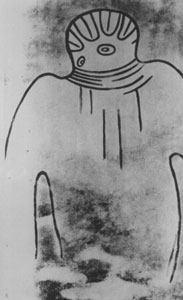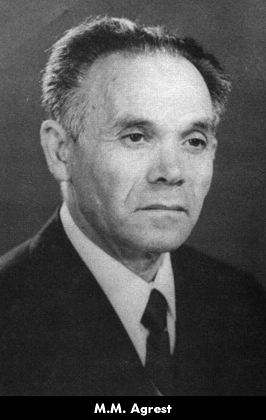paleocontact hypothesis

Lhote's 'great martian god'.

Matest Agrest.
The paleocontact hypothesis, also referred to as the ancient astronaut hypothesis, is the notion originally proposed by Matest M. Agrest, Henri Lhote, and others on a serious academic level, and frequently put forward in pseudo-scientific and pseudo-historic literature since the 1960s, that advanced extraterrestrials have played an influential role in past human affairs. Its most outspoken and commercially successful advocate has been the writer Erich von Däniken. Although not an unreasonable idea in principle (see sentinel hypothesis and alien artifacts), there is a lack of convincing, substantive evidence to support it. Moreover, when specific claims are examined in detail, other, less exotic explanations can usually be found. A case in point concerns the Dogon tribe and their remarkable knowledge of the star Sirius (see Sirius, mystery of red color).
Agrest, Matest M. (1915–2005)
Matest Agrest was a Russian-born ethnologist and mathematician who, in 1959, proposed that certain monuments of past cultures on Earth have resulted from contact with an extraterrestrial race. His writings, together with those of a few other academics, such as the French archaeologist Henri Lhote, provided a platform for the paleocontact hypothesis which was later popularized and sensationalized through the books of Erich von Däniken and his emulators.1
Born in Mogilev, Byelorussia, Agrest graduated from the University of Leningrad in 1938 and received his PhD in 1946. He became chief of the university's laboratory in 1970. He retired in 1992 and emigrated to the United States. Agrest startled his colleagues in 1959 with his assertion that the giant terrace at Baalbek in Lebanon had been used as a launch site for space vehicles and that the destruction of the Biblical Sodom and Gomorrah (twin cities in ancient Palestine on the plain of Jordan) was caused by a nuclear blast. His son, Mikhail Agrest, has advocated similarly unorthodox views.
Agrest, Mikhail M.
Mikhail Agrest was an instructor in the Physics and Astronomy Department of the College of Charleston, South Carolina, and son of Matest Agrest. Following his father's tradition of seeking explanations for certain unusual terrestrial events in terms of extraterrestrial intelligence, he interpreted the Tunguska phenomenon as the explosion of an alien spacecraft. This idea was supported by Felix Zigel of the Moscow Institute of Aviation who suggested that the object had made controlled maneuvers before crashing.
Däniken, Erich von (1935–)
Erich von Däniken is a Swiss author of several best-selling books, beginning with Erinnerungen an die Zukunft (1968, translated in 1969 as Chariots of the Gods?), which promote the paleocontact hypothesis. Although the underlying thesis of past extraterrestrial visitation is not implausible, the evidence that he and others have assembled to support their case is suspect (often simply false and manufactured) and undisciplined. Nevertheless, von Däniken's works have sold in their millions and testify to the genuine desire of many ordinary people to believe in intelligent life beyond the Earth.
Just as Adamski's popular, and also purportedly non-fictional, books answered a need of millions to believe in the extraterrestrial hypothesis during a time when nuclear war seemed imminent (see Cold War, linked to UFO reports), so von Däniken, more than a decade later, was able temporarily to fill a spiritual vacuum with his tales of ancient astronauts and God-like wisdom from the stars.
Lhote, Henri (1903–1991)
Henri Lhote was a French ethnologist and explorer who discovered important cave paintings at Tassili-n-ajjer in the central Sahara and wrote about them in The Search for the Tassili Frescoes, first published in France in 1958.1 A curious figure reproduced in this book (shown left) was referred to by Lhote as Jabbaren, the "great martian god." Although it transpired that this picture and others of strange appearance in fact represent ordinary humans in ritual masks and costumes, the popular press made much of this early paleocontact hypothesis and it was later borrowed by Erich von Däniken as part of his sensationalist claims of "ancient astronauts."
Reference
1. Lhote, Henri. The Search for the Tassili Frescoes. New York: E. P. Dutton.


